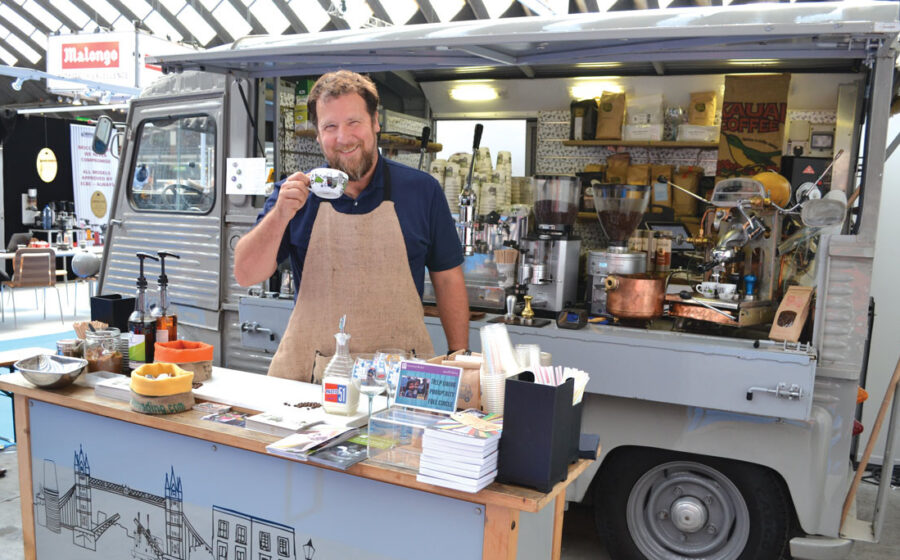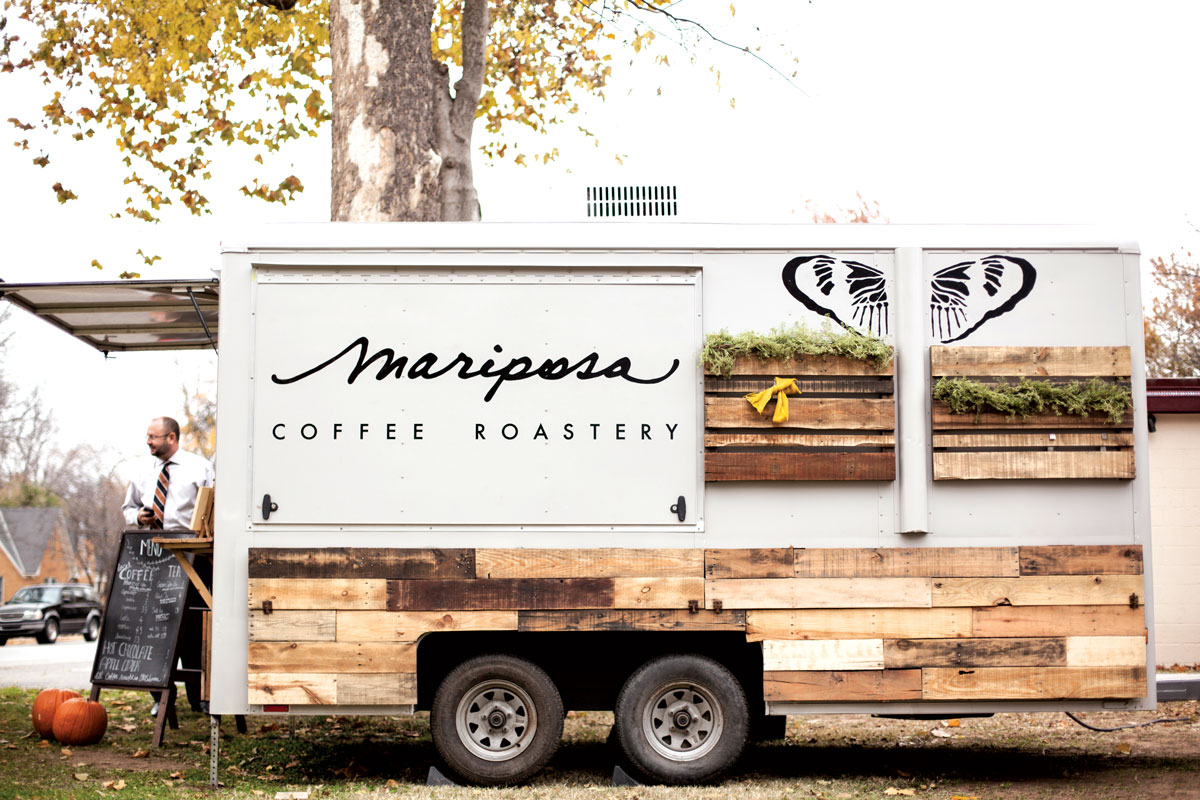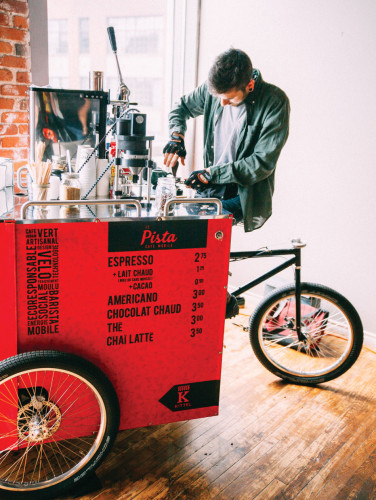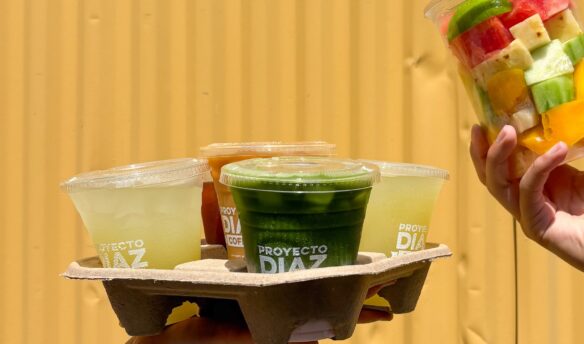[O]n a hot and sunny Thursday afternoon in Portland, Oregon, Charlie Wicker is roasting coffee in the back of Trailhead Coffee Roaster’s Accidental Café. The space is essentially a tasting room for the bicycle- and outdoor-centric coffee business. It’s the peak of summer, and several large fans circulate hot air through the high-ceilinged room.
As he empties crackling beans from his Diedrich machine, Wicker admits the setup is not ideal. Trailhead will move to a larger, more ventilated space later this year, sharing their café and roastery with a chocolatier, but in the meantime, he seems content, despite the heat.
Chatting with Wicker about his Trailhead, a bike-delivered coffee business he began in 2009, it becomes clear why. The spirit of Trailhead exists outside: on Portland’s bike-friendly streets, in its parks, at local farmer’s markets, and outdoor events like the ones hosted by Cycle Oregon.
His passion for moving coffee sans engine—and brewing coffee outdoors—is in everything he does. Trailhead’s coffees are delivered by a custom delivery cycle that doubles as a pour-over café. The heart and soul of the company are on the go, out-of-doors, and pedal-powered. Wicker says he couldn’t envision his company any other way. “It’s almost like it had to be like that,” he muses.
This sentiment is growing as mobile coffee and tea carts slowly carve a genre into the food and beverage world. Somewhere between food trucks and drive-through espresso stands exists a paradigm of coffee brewed on the go, with ease, in a fun and different way. Mobile coffee carts might have once been considered gimmicky, temporary, or a means to an end (that is, a permanent locale). But today, beverage bikes, trucks, auto rickshaws, vans, Airstreams, and more make up a new kind of café culture not inhibited by permanency or walls.
Meeting The Community Anywhere, Everywhere
The attitudes of the industry’s mobile pioneers reflect the open-air quality of what they do: they want visibility, flexibility, and fun. They’re excited about their mobile setups, and they’re sticking with them.
“Coffee is much more than a beverage,” says Amyie Kao, co-founder of Oklahoma City’s Mariposa Coffee Roastery and its coffee truck, with her husband, Daniel. “It has the power to shape the atmosphere of a gathering, the experience of a story, and transform a setting. Mostly, I think mobile coffee appeals to those with a sense of adventure, who are also fond of the outdoors and walkability.”
Mariposa was born out of a desire to aid the community in a time of need. When a tornado tore through Oklahoma City in the spring of 2013, the Kaos were desperate to help somehow. So they brewed up coffee the following day and served it in the rain to firefighters and volunteers in the damaged part of town.
They realized then that if they had a coffee truck, they could serve the community wherever. Today the duo keeps regular truck hours at their roastery and offers coffee catering at weddings and other events. The truck is their lifeline to the community.
Racing to Catch Up
Although popular abroad, mobile coffee and tea setups are still catching on in the United States. In Portland, a city known for its food trucks, craft coffee, and eccentricity, Wicker’s custom coffee cycle—modeled in hardwood to look like a small teardrop trailer with LED striping for nighttime rides—is business as usual. But throughout most of the United States, a driving culture keeps brew bikes and the like a second consideration, while coffee stands, cafés, and drive-throughs are much more the norm.
It’s not clear why mobile hasn’t caught on more widely. For Trailhead and Mariposa, a storefront wasn’t necessary to contribute to the local community and coffee culture, nor was an excessive amount of capital. In coffee-crazed cities like New York and Los Angeles, where rents are skyrocketing, opening a brick-and-mortar shop—and making it successful—is becoming harder and harder. Mobile cafés don’t require as much start-up money, and because they can go anywhere (location is important and changeable), they choose their market and sell when the selling is good.
In Europe, mobile cafés are a more natural part of the landscape, found near iconic landmarks dotting ancient grids. In England, where specialty coffee and tea are quickly taking root, mobile cafés fulfill a need for coffee on the go, easily accessible on foot, by bike, and in places cafés either aren’t allowed or won’t fit, like town squares and grand parks.
Olivier Vetter is the company director of Bean About Town, which has strategically placed coffee carts across London. He agrees mobile coffee is a comfortable entrance into the coffee world but is even more attracted to the ingenuity of mobile cafés.
Each of Bean About Town’s locations is unique—the company teaches passionate individuals how to manage a cart, an auto rickshaw, or Citröen van, then gives them the reigns to get creative. Locations in high-profile areas like the St. Katharine Docks and Kentish Town have been highly successful. “I want to show people that you can create something and be passionate about it in the hospitality industry,” says Vetter.
Innovating On The Go
Lasse Oiva and Amos Field Reid saw the rise in mobile and decided to take the concept one step further. They invested their design and technology expertise and drew on their love of cycling to create Velopresso, an innovative coffee-vending trike that became available for purchase last month. The UK team spent three years developing the ergonomic, pedal-powered vehicle with help from English coffee machine manufacturer Fracino.
Unlike many mobile cafés, Velopresso requires no electricity, just a cylinder of gas to heat the boiler in the espresso machine. Everything else—grinding, pumping water, and getting around—relies on the driver’s pedaling. Several pre-production models sent to existent coffee companies, one in Montreal, one in France, and one in London’s Convent Garden area, are up and running smoothly.
The sophistication and style of Velopresso is indicative of a mobile trend not to skimp on high-end features and give the same attention to a truck or bike as one would outfitting a new café. Likewise, the mission of Velopresso—to make a vehicle that can go anywhere where electricity is scarce, from Italian piazzas to parks with motorized vehicle restrictions—is an impressive one that encapsulates the sense of freedom that comes with owning a business that moves.
Always on the Move
Some in mobile coffee might come off as restless spirits, but they’re rooted in their businesses, despite their nomadic nature. They’re entrepreneurs who don’t like office hours, enjoy open spaces, and are mindful of their carbon footprint. Some mobile business owners are looking to save away for a permanent store, but a growing number want to see just how far mobile can take them.
David Simon’s Black Magic Coffee cart, which you can spot at farmer’s markets, weddings, fundraisers, and local events around the Boston area, was a life-changing venture for the former healthcare professional. Simon replied to an e-mail question about his future goals for Black Magic, “A coffee truck perhaps? We can’t sit still for long.”
Wicker of Trailhead is sure he will never switch from custom cycles. Though many have told him he would eventually have to invest in a motorized delivery vehicle if the company’s growth keeps up, he doesn’t see why. “We’ll just augment the fleet with more and more bikes,” he says.
Owning a café isn’t easy—things like plumbing, lighting, sound systems, and machinery break. Utilities spike, rents go up, and furniture sags and requires replacing. There is undeniable goodness in providing your community a comfortable haven, a “third place,” for those thirsty and in need of a break. But there’s something to be said for stripping all of that away, too.
Wicker’s custom cycle is his car, his café, and a way to tote his two young children around town. It’s a fresh-air way of life that would be difficult not to enjoy. “If you’re in a bad mood when you’re drinking coffee outside,” he says, “something isn’t right.”
Regan Crisp is Fresh Cup’s associate editor. Cover photo by Laurette Wilkie.
This article was originally published on September 15, 2014 and has been edited to reflect Fresh Cup’s current editorial standards.



















